Bacon Wrapped Filet Mignon is the impressive gold standard of steak that exudes elegance but is surprisingly easy to make!
Bacon Wrapped Filet Mignon seared in garlic herb butter on the stove and finished in the oven might be the best steak ever. It’s juicy, buttery tender, and dripping with unforgettable flavor. Add a drizzle of balsamic chive cream sauce, herb butter or horseradish sauce for the perfect melt-in-your-mouth bite. Best of all, this filet mignon recipe may look impressive but requires minimal prep and minutes of hands-on cooking time. In this post, learn the easy chef-inspired techniques to obtain the perfect temperature, texture, and flavor every time even if you have never made steak before! Serve your Bacon Wrapped Filets with twice baked potatoes, balsamic asparagus and winter fruit salad and bask in the flood of compliments!
If you also love steaks, check out: NY strip steaks in harissa butter, sirloin steaks with Cajun Butter, marinated flank steak, carne asada, street tacos, mojo steak tacos, steak fajitas, Cajun steak, classic steak kabobs, Brazilian steak kabobs, etc. and oof course this brand new strip steak recipe!
This is a detailed guide about how to cook filet mignon. If you wish to skip directly to the recipe, use the “Jump to Recipe” button at the top of the post.
Pin this recipe to save for later
How to cook Bacon Wrapped Filet Mignon Video

Filet Mignon Recipe
Can you believe Christmas is here?! I have many delicious, comforting special occasion recipes, but it’s hard to beat juicy, tender, Bacon Wrapped Filet Mignon. This recipe feels extra special, is extra easy, practically foolproof and is finished off with the most ridiculously delicious Balsamic Chive Cream Sauce. If you ever wanted dinner to impress, this recipe is it!
Why this recipe works
- It’s perfect for any occasion. Bacon Wrapped Filet Mignon is a surprisingly easy recipe that exudes elegance. Halve the recipe for date-night-in or Valentine’s Day, or serve it for birthdays, Christmas, anniversaries or any time you want to enjoy a low maintenance yet high reward, highly impressive meal.
- This stunner is quick and easy to prepare. Season the steak while the bacon is par-cooking in the oven, wrap the filets in bacon and secure with butchers’ twine or toothpicks, sear, then transfer to the oven. Done and done!
- The bacon adds flavor and juiciness. The bacon isn’t just for beautiful presentation, it creates the juiciest filet mignon you ever sunk your teeth into with a tantalizing crispy bacon crunch.
- The steaks are spice rubbed in more than salt and pepper. The simple spice rub brings the wow factor while still showcasing the gorgeous flavor of the steak.
- The steaks are seared in oil and cooked in butter. This promotes a deeply caramelized crust without burning the butter while reaping the flavorful, juicy tenderness of the fresh garlic and rosemary infused butter.
- The steaks are seared on the stove and finished in the oven. This method will change your steak cooking forever! It locks in all of the juices and flavors while delivering the coveted charred crust and evenly cooked buttery soft steak every time.
- Cook the steaks exactly how you like. You can even cook steaks different temperatures from rare, medium-rare or medium.
- Serve with any sauce. You can serve this filet mignon steak recipe with the balsamic chive cream sauce (pictured) horseradish sauce (divine) or classic herb butter and each promise an extravagantly delicious bite.
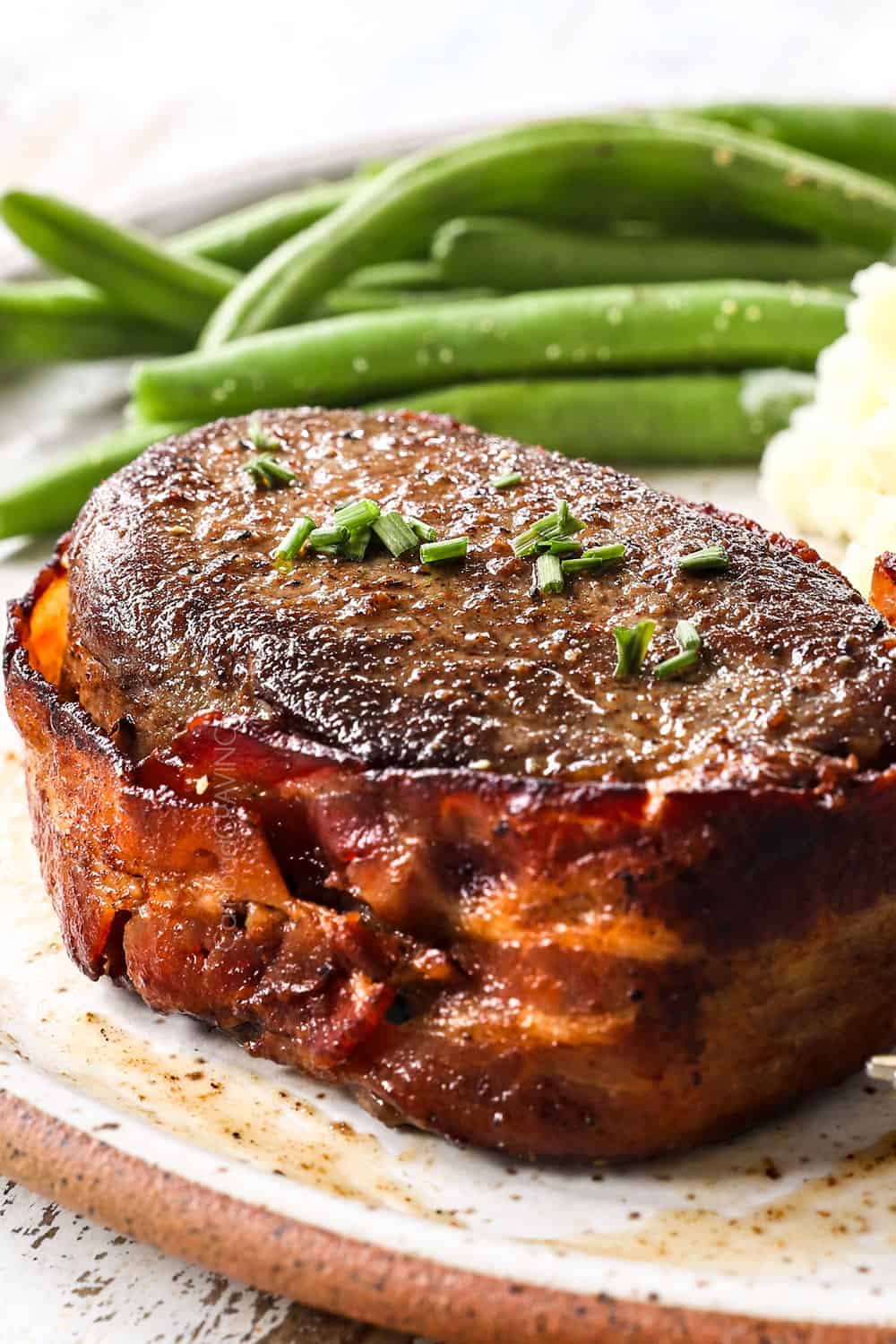
WHAT IS filet mignon?
Filet mignon (pronounced fee-le mee-nyawn) is an expensive, lean yet incredibly tender type of beef steak often served at high end restaurants. Here’s what to know:
- What makes filet mignon so special? Filet mignon is considered the king of steaks because it is the most tender cut of beef with swoon worthy melt-in-your-mouth texture. A prime cut filet mignon can literally be cut with a fork.
- What does filet mignon mean? Filet mignon is a French name, with filet meaning thread or strip and mignon meaning small and pretty. It is aptly named because it is a small cut from the strip of beef tenderloin. It is also known as: Filet, Filet Mignon, Fillet, Tenderloin Filet, Tenderloin Steak, Tournedos (Tenderloin Tips).
- What does filet mignon taste like? Filet mignon is known for its soft, buttery tender, melt-in-your mouth texture. It is a lean yet succulent cut of meat, very fine-grained and low in fat, which also means it is quite mild and subtle in flavor and not nearly as flavorful as ribeye, NY steak, or even top sirloin. Filets are often cooked with added fats such as butter or bacon (like in this recipe!) to keep the steak moist and tender and prevent it from drying out. Filet mignon is almost always served with a flavorful sauce to add additional flavor as well.
- What cut of meat is filet? Filet mignon is a slice of beef taken from the smaller end of the beef tenderloin, which is found inside the rib cage of the cow. This muscle is not weight-bearing and performs very few actions so it has very little connective tissue and muscle fibers traditionally toughened by exercise. As a result, filet mignon is an extremely tender. The Chateaubriand, Porterhouse and T-bone steaks also include the filet mignon as the medallion of meat on the other side of the bone across from the sirloin.
- What size and shape is filet mignon? Filet mignon is naturally rounded or oval because it comes from the tube-shaped muscle. This muscle is cut into slices which are usually 1 to 2 inches thick and 2 to 3 inches in diameter. You may also see smaller pieces taken from the tapered end of the tenderloin, next to the “tail” which are no more than an inch in diameter. Average tenderloin steak weighs 8 ounces although you may also see 10 or even 12-ounce filets.
- What’s the nutritional value of a tenderloin steak? An 8-oz portion contains 1-gram total carbs, 1 gram net carbs, 12 grams fat, 42 grams protein, and 290 calories. It is a good source of a number of B vitamins, magnesium, phosphorus and potassium.
HOW TO PURCHASE filet mignon
Filet Mignon is an expensive cut of beef, so you should know how to select the best quality for your money.
- How much filet mignon do I need per person? The general rule of thumb is to allow 8 oz. of steak per person, so you will need one tenderloin filet per person.
- What should I look for when buying filet mignon? Look for Prime or Choice cuts (more on that below) well-trimmed steaks without any silverskin, even, modest marbling, and a nice bright red color. Try and purchase steaks of similar size, about 8 ounces each, and thickness, about 1 ½-2 inches each, to ensure even cooking time. This is the best size for a gorgeous caramelized crust while the interior remains a juicy medium-rare. As the steaks get thicker, they are tougher to cook through without overcooking the exterior.
- What is the price of filet mignon? Why is filet mignon so expensive? Filet mignon is so expensive because it is lean yet succulent and considered the most tender cut of steak. It is particularly expensive right now, ranging from $20 to $25 per pound although you may have luck with sale deals or better priced options at Costco. The price will depend on the size, the steak grade, if it’s organic, your geographical location and where you purchase it. Although this tenderloin filet is quite costly, it’s much less expensive to make at home than dining out. Just make sure you make it worth it with an exceptional recipe like this one!
- Where to buy tenderloin steaks? Filet mignon is widely accessible and should be easy to find. I recommend going to your local butcher because they will have the freshest meat and can cut the steak to your specifications right then and there. If you can’t source a local butcher, ask the butcher at the supermarket to cut the steaks for you so you know you’re getting the freshest cut possible. You can even call ahead and speak with the butcher. Increasingly, groceries are selling the highest quality Prime meats as well. I have purchased Prime Aspen Ridge Natural Angus Beef at Pavilions and Vons. You can use their store locator here. You can also purchase grass fed and aged steaks for a higher price from retailers such as Omaha Steaks, Kansas City Steaks, etc.
What grade of beef should I buy?
While filet mignon is considered the choicest cut of meat, not all are created equal. Steak is graded by its quality in tenderness, juiciness and flavor and divided into three grades: Prime, Choice and Select. Select PRIME or CHOICE for this recipe. Here is the breakdown:
- Prime: is the highest rated in tenderness, juiciness and flavor due to richer marbling. Less than 2% of all beef produced in the United States will earn the top Prime designation. Prime graded beef is so superior that it’s snatched up by high-end restaurants and hotels. When it comes to tenderloin steaks, Prime filets are generally so tender they can be cut with a fork. Look for Prime cuts at Costco, some butchers and grocery stores.
- Choice: is also high quality but boasts less marbling than Prime. It is still tender, juicy and flavorful especially when not over cooked, and definitely is a great choice as well. The filets in this recipe are wrapped in bacon which helps make up the difference between Choice and Prime.
- Select: the lowest quality of beef that should be avoided when dealing with tenderloin steaks. The price differential between Choice and Select usually isn’t that much, but you’ll taste the difference in quality.
Why wrap filet mignon in bacon?
As noted, filet mignon is one of the leanest and therefore most tender cuts of beef. This also means it’s lacking in flavor, because fat equals flavor. Bacon, however, remedies all that.
Wrapping a tenderloin steak in bacon serves three purposes:
- 1) infuses the filet with savory, salty, umami goodness as it bastes the filet with bacon fat
- 2) prevents the filets from drying out, making them even more succulently juicy as the fat seeps into the steaks
- 3) creates a caramelized crust from the extra fat
In short, Bacon Wrapped Filet Mignon is always the answer!
Ingredient notes
The ingredients are very simple but each plays an important role in the best filet mignon!
- Bacon: you must use regular bacon, NOT thick cut bacon. Thick cut bacon is too thick and will not become crispy but remain soggy when overlapped. I like to use smoked hickory for extra flavor. You will need 8 slices of bacon, 2 per filet because the bacon shrinks significantly when par-cooked before wrapping the filets.
- Oil: is used to sear the steaks on the first side before adding the butter and helps prevent the butter from burning. Use a neutral, high smoking point oil such as vegetable oil, canola oil or grapeseed oil. Do NOT use olive oil because it has a lower smoking point and will break down.
- Butter: infuses the steaks with buttery goodness and moisture. You can use salted or unsalted butter in this recipe.
- Kosher Salt: is a preferred for steaks because its large texture doesn’t clump like table salt. If you only have table salt, use HALF the amount.
- Pepper: this recipe calls for freshly cracked pepper which is exactly what it sounds like. Grind the pepper until it measures 1 teaspoon. If you are using finely ground pepper, you will need to use HALF the amount.
- Rosemary: infuses the melted butter that is basted over the steaks with subtle, complex pops of evergreen, citrus, lavender, pine, sage, pepper, mint, and sage notes AKA herb magic!

Filet Mignon Sauce
I’ve included a Balsamic Chive Cream Sauce, but you can also serve simply with a pad of butter, herb butter or browned butter. Here’s what you’ll need for the filet mignon sauce:
- Chicken broth: is simmered and reduced for extra flavor.
- Heavy cream: also known as “heavy whipping cream” is what makes it creamy!
- Balsamic vinegar: adds a slight tanginess to cut through the creaminess. Use quality balsamic vinegar for the best flavor.
- Dijon mustard: adds a depth of complex tanginess. You can use any type of Dijon you prefer.
- Chives: tastes like mild onion with a slight garlicky note but they are actually classified as an herb verses an onion. When purchasing chives, look for plump green stems without brown spots or wilting.
- Salt and pepper: make sure to generously season or the sauce or it will taste flat.
filet mignon RECIPE VARIATIONS
One you have the technique down for cooking filet mignon, you can go rogue and create all sorts of variations. Here are a few to try:
- Simplify the sauce. For a Dijon sauce, skip the balsamic in the reciep and increase the Dijon to 2-3 teaspoons.
- Use herb compound butter. Swap the butter for a simple compound butter made with 8 TBS butter, 2 tablespoon herbs such as any combo parsley, thyme, oregano etc., 1 ½ tablespoons chives, 1 teaspoon lemon zest and 1 teaspoon Dijon mustard or horseradish. You can cook with the herb butter and/or just top the steaks with the butter.
- Swap the sauce. Pair the steak with horseradish sauce, Béarnaise sauce, mushroom sauce, peppercorn sauce, red wine sauce, balsamic reduction, mustard sauce, blue cheese sauce, chimichurri, salsa verde, etc.
- Use different seasoning. experiment with different seasonings like the one I use in my sirloin steak, barbecue brisket and ribs recipe, or Cajun seasoning Fajita seasonings, or Asian inspired seasonings such as Chinese 5 Spice, ginger and garlic.
- Swap the herbs. Swap the rosemary for thyme or use a combination.
- Toppings. Serve with browned butter sautéed mushrooms or caramelized onions.
What’s the best way to cook filet mignon?
The true secret to cooking the perfect filet mignon is to combine pan searing with an oven finish. This method delivers evenly cooked steaks every time with a beautifully seared outside, juicy, tender inside, and allows you to baste the steak in butter for extra flavor before popping in the oven. The steaks are so thick that if you attempt to cook your steaks in the skillet only, they will not cook evenly and the outside is likely to burn. The oven, on the other hand, provides the indirect heat necessary for even cooking.
How to cook bacon wrapped filet mignon
The beauty about Bacon Wrapped Filet Mignon is that anyone can make them! Although this post is a detailed guide, don’t be overwhelmed, the actual hand’s-on cooking time is minimal and requires very little skill. Here is how to make this recipe (see measurements in the recipe card at the bottom of the post):
- Step 1: Let the steaks rest. Remove steaks from refrigerator 60 minutes before cooking to bring to room temperature. This helps the steaks cook more evenly and creates juicer results.
- Step 2: Season the steaks. Pat the steaks dry and season all sides with the spice mix, pressing it into the steaks so it sticks; set aside. It is best to season the steaks as soon as you remove them from the refrigerator.
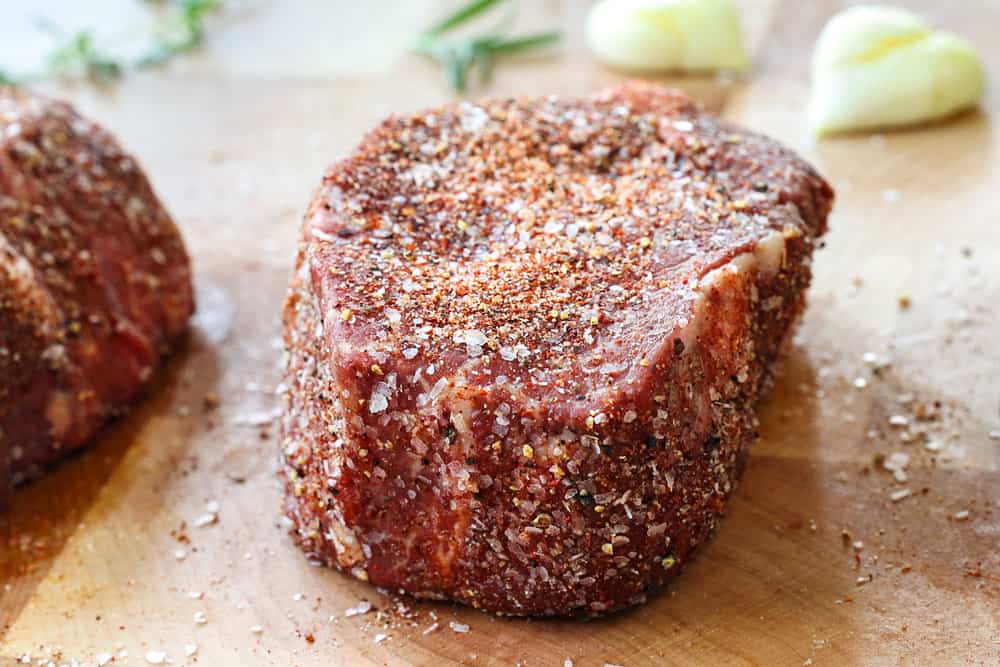
- Step 3: Par-cook the bacon. Bake the bacon for 6-10 minutes until the strips are beginning to turn golden but are still pliable. If you don’t par-cook the bacon, you won’t be rewarded with crispy bacon.

- Step 4: Wrap filets in bacon. Using two bacon strips per steak, wrap the steak completely with the bacon. Despite the pics, I highly suggest securing the bacon with cotton butcher’s twine instead of toothpicks. The toothpicks can tear through the bacon. The twine, however, works perfectly every time.
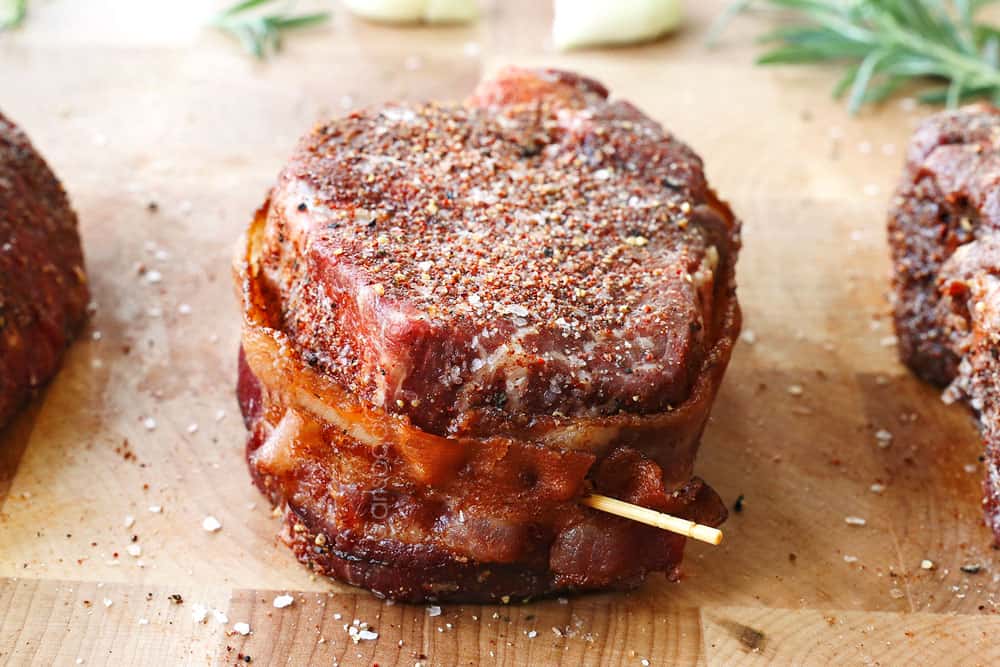
- Step 5: Sear the steaks. Heat oil in a cast iron skillet until smoking, then add the steaks. Sear the filets for 2 minutes, flip, then add the garlic, butter and rosemary. Adding these ingredients after flipping prevents them from burning. Cook an additional 2 more minutes, tilting the skillet as needed and basting the steaks with the melted butter.
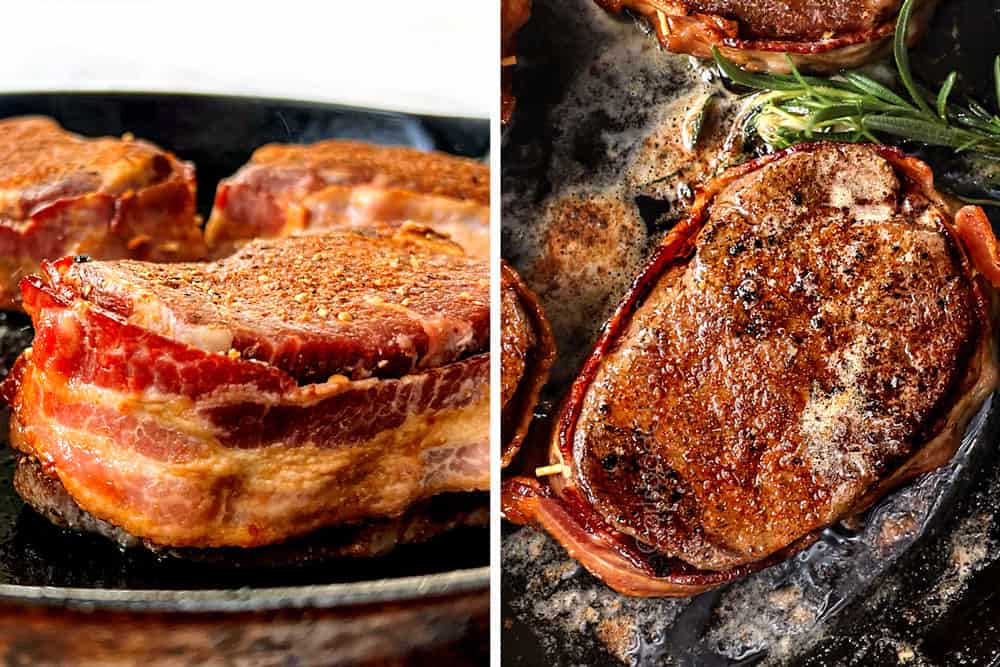
- Step 6: Finish the steaks in the oven. Transfer the skillet to the oven and cook to your liking, then transfer the steaks to a cutting board to rest.
- Step 7: Make the sauce. Drain some of the fat/juices from the skillet but leave the rosemary and garlic. Add chicken broth and simmer for a couple, minutes, then stir in the heavy cream, balsamic vinegar and Dijon and simmer until slightly thickened. Remove the rosemary and garlic with a slotted spoon then stir in the fresh chives and season with salt and pepper to taste.
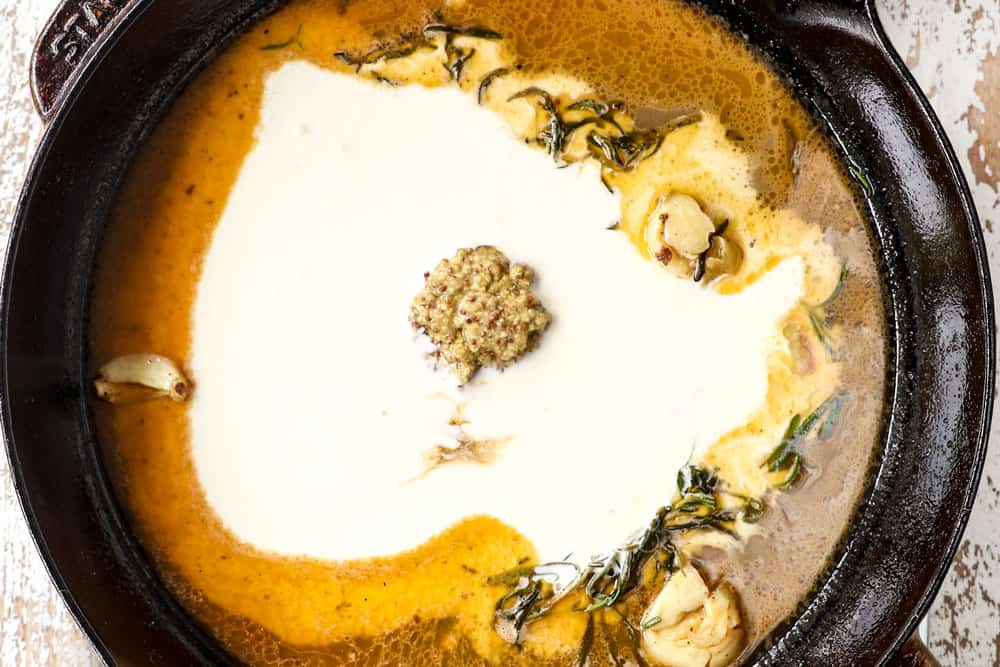
- Step 8: Serve. Drizzle the sauce over the tenderloin steaks or serve alongside. Dig in!
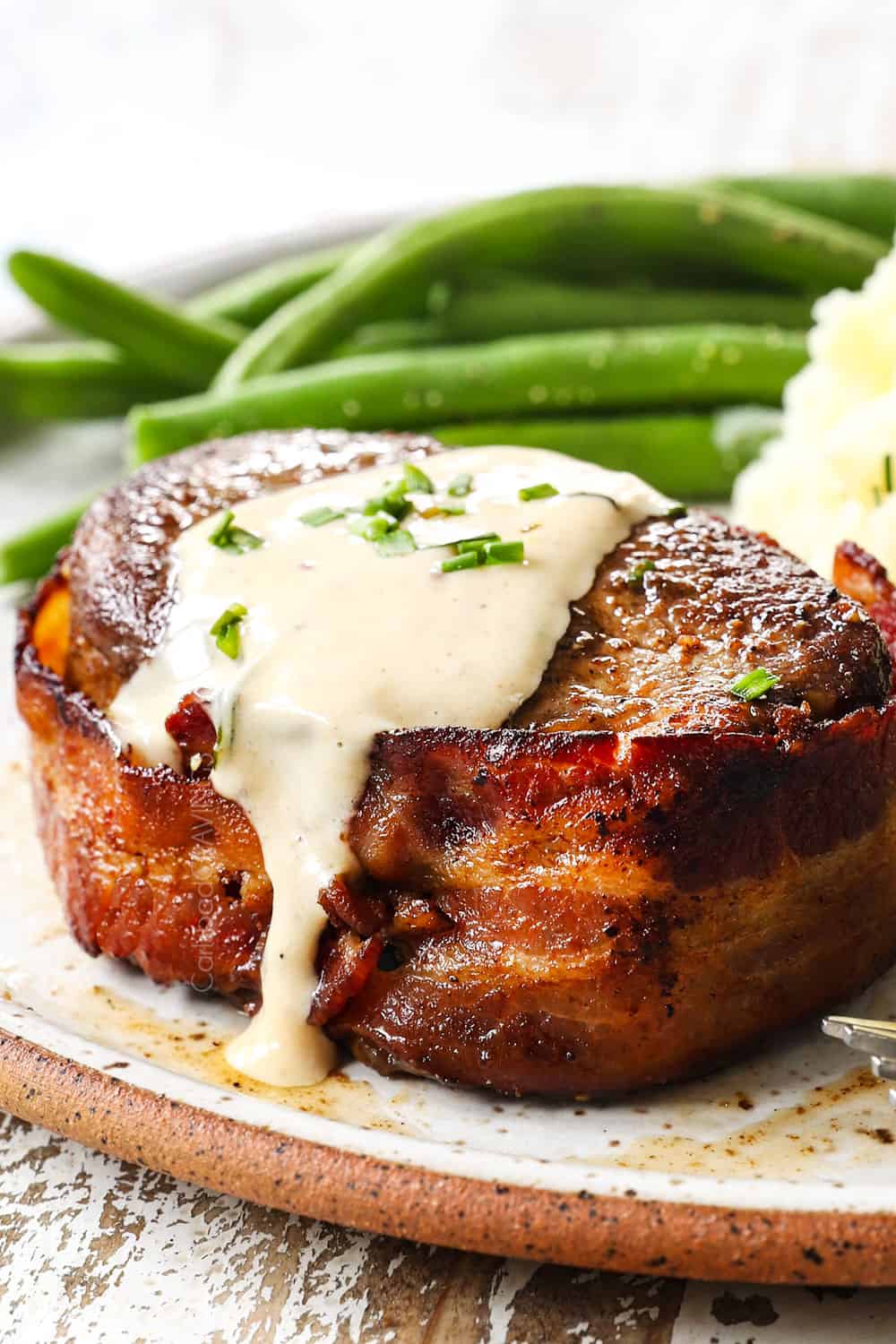
How Long Do I Cook Filet Mignon?
There are a few variables when it comes to filet mignon cooking times, but generally, you will sear the steaks for 2 minutes per side on the stove then transfer the filets in a cast iron skillet with butter to an oven preheated to 425 and cook for 4 to 9 minutes. For rare, bake for 4 minutes; medium rare, 5-6 minutes; medium, 6-7 minutes; medium well, 8-9 minutes.
You can use this as a general guideline but it is best to always use an instant read thermometer because the total amount of time it takes to cook the filets depends on a few factors:
- How thick are your steaks? 1 inch, 1 ½ inches, 2 inches, 2 ½ inches?
- How much do your steaks weigh? 4 ounces, 8 ounces, even 12 ounces?
- What is the starting temperature of the meat? Has it been resting for 60 minutes, 20 minutes? In a warm kitchen or cold kitchen?
- Did you season the meat immediately? Seasoning the meat immediately and letting the salt rest for 40 minutes serves as a dry brine and will cause the steaks to cook more quickly.
- What temperature is your skillet going into the oven? This is influenced by your stove and the skillet material.
- What temperature do you want your steak? Rare, medium-rare, medium or medium-well all require different cooking times.
filet mignon TEMPERATURE
Filet mignon is a lean cut of meat with very little fat so it’s the juiciest when cooked to medium-rare. Therefore, aim for an internal temperature of 130-135ºF, after resting (account for 5 degrees of carryover), for medium-rare.
Medium-rare filet mignon is the juiciest because the moisture inside the steak can’t escape at these low of temperatures. Higher temperatures, however, quickly denatures the protein strands, making them tough, dry and chewy.
Use the below temperature chart to gauge your steaks doneness. To check the temperature, insert the probe of an instant read meat thermometer into thickest part of the steak. You want the temperature to register 5°F lower than the desired final temperature because the steaks will continue to cook and rise in temperature (carryover) while resting.
| Doneness | Final Temperature | Remove from Heat at this Temperature | Color | Oven Duration Approximations |
| Rare | 125°F | 120°F | Cool red center | 4 minutes |
| Medium Rare | 135°F | 130°F | Warm red center | 5-6 minutes |
| Medium | 145°F | 140°F | Warm pink center | 6-7 minutes |
| Medium well | 155°F | 150°F | Slightly pink center | 8-9 minutes |
| Well done | 160°F | 155°F | Little or no pink | 10+ minutes |
NOTE: The USDA recommends steaks and roasts be cooked to 145°F and then rested for at least 3 minutes for safety.
HOW do i not overcook filet mignon?
As discussed, there are so many variables when cooking tenderloin steaks, such as the thickness of your steak, the heat of your skillet, your type of skillet, and your desired level of doneness – each will all impact the time it takes to cook your steak. To eliminate the guesswork and guarantee perfectly cooked, juicy steak every time, invest in an instant read meat thermometer.
You can pick up an inexpensive instant read thermometer at the grocery store or Amazon, or I am obsessed with this digital probe thermometer – you will never overcook any protein again! Instant read thermometers can be temperamental, but this digital probe thermometer retrieves temperature precisely to within ±1.8°f (±1°c ) and you leave it in the steak while it cooks, whether on the stove, grill or oven.
The digital thermometer allows you to set the desired temperature for each of the two probes and an alarm will set as soon as it reaches the set temperature – so walk away and be rewarded with perfectly cook filet mignon every time.
How Long Should I Let Steaks Rest?
After the filets are cooked, immediately transfer them to a plate or cutting board so they don’t continue to cook. As a rule of thumb, you want to let your steak rest for at least half of its total cooking time before slicing, so stick with 5-10 minutes to be safe.
While the steak cooks, the juices are forced away from the heat to the middle of the meat. The resting time allows for the redistribution and reabsorption of the juices throughout the whole steak for optimal flavor and juiciness. If you don’t allow for this calming period, valuable juices will seep out and be lost when you slice into the filet, resulting in less juicy beef.
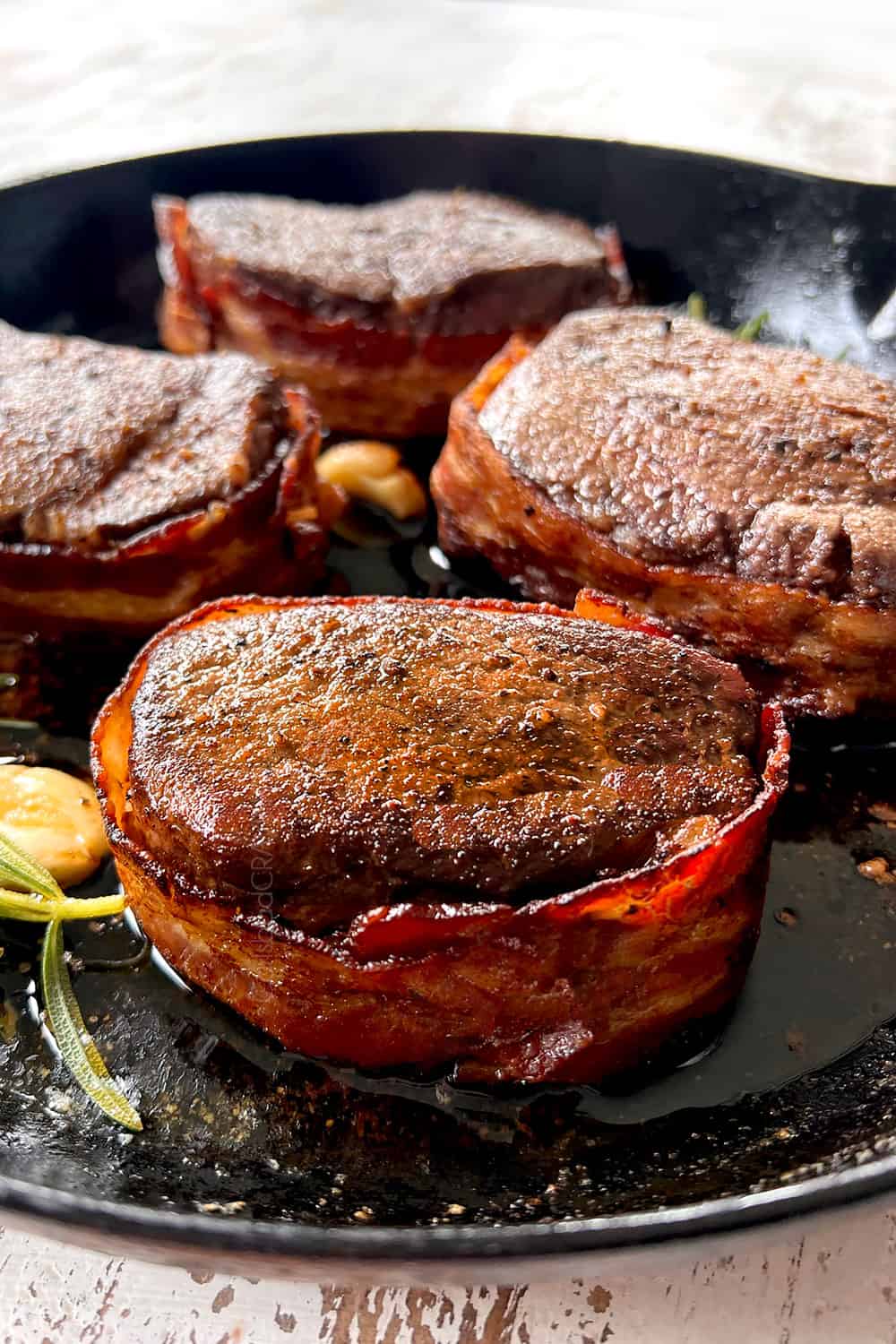
TIPS FOR COOKING THE BEST filet mignon
- Try and purchase steaks of an even size and thickness so they cook evenly. If the butcher is cutting them for you, this isn’t always possible because they are being cut directly from the tenderloin which tapers in size. At the very least, make sure they are the same thickness so they cook at a similar rate.
- Take the steaks out of the refrigerator at least an hour before cooking so they cook more evenly. Cold steaks will leave you with a quick cooking, even burnt, outside and a cold, under-cooked inside.
- Remove the silverskin. Your tenderloin steaks should come trimmed of the silverskin, but if not, you’ll need to trim it. The silverskin is a shiny white strip of cartilage that will stay tough and chewy even when cooked.
- If you have less than 40 minutes, it’s best to season the steaks right before cooking. Otherwise, the salt will draw out the liquid onto the surface of the steaks (you can actually see it) and there isn’t sufficient time for it to reabsorb back into the steak, causing the meat to become dry.
- To season the steaks properly, first pat the steaks dry with paper towels. This will allow the steaks to sear and caramelize instead of steam.
- Don’t skip par-cooking the bacon. The bacon needs a head start or else the fat won’t render in the allotted time and it will remain soft or soggy.
- Get the vents going. Cooking steaks in a smoking hot skillet tends to get smoky. Get your kitchen overhead vent fan going and/or open a window before you start cooking to help with ventilation.
- Heat the skillet until smoking. This can take up to 5-10 minutes on some stoves, so be patient. A smoking skillet is key to a good sear. This high heat causes the chemical Maillard reaction in which the amino acids and reducing sugar react to create a caramelized, deeply flavorful, rich savory crust.
- Flip the steaks with tongs. You never want to use a fork or a utensil that can pierce the filets because you will continuously loose juices and tenderness.
- Use an oven mitt. If your cast iron pan doesn’t have a heat proof, enameled coating, be prepared with an oven mitt to hold the handle in order to tilt the skillet to baste with butter and to transfer the skillet to the oven. In the hustle and bustle of the moment, you might forget, so make sure to set the mitt out so you don’t accidently touch the scorching handle and burn yourself!
- Don’t overcook. Filet mignon is so lean that it dries out easily if overcooked. Use an accurate instant read thermometer for perfectly cooked steaks. Or better yet, I suggest this digital probe thermometer, which is inserted into the steaks and reads the temperature while they are cooking.
- Test individual filets for doneness. Your filets will likely not be 100% uniform in size, so check the smallest filet for doneness first and be prepared to remove individual filets from the oven as needed. Different size filets can work out perfectly, however, if individuals in your household like different temperature filets, then you can remove them from the oven at the same time.
- Do not rest steaks in the cast iron pan after cooking. Transfer steaks to a plate as soon as they are finished cooking and let them rest for 5 minutes before serving. Do not let them rest in the hot skillet off-heat or you’ll end up with overcooked, tough steaks.
- Remove the filets from the oven 5 degrees before they’ve reached their desired final temperature. The steaks will continue to rise in temperature while they are resting. Remember, you can always pop the steaks back in the oven, but you can’t un-cook them!
- Let the steaks rest. Do NOT skip the resting period once the filets are pulled from the oven. If you cut into the tenderloin steaks right away, the juices will ooze right out and you’ll be left with a potentially dry steaks. Letting the filets rest makes them ultra-moist and juicy!
Do I Need a Cast Iron Skillet?
Cast iron is considered the gold standard for steak because:
- It durable; can become screaming hot without warping
- retains and distributes heat extremely well at a consistent temperature
- seamlessly transfers from the stovetop to the hot oven
All of these factors combine to achieve a beautiful crispy, golden seared crust and a tender perfectly juicy interior.
If you don’t own a cast iron skillet yet, you will not regret the purchase! Cast iron is a durable, chemical-free alternative to chemical-laden non-stick finishes. The more you use cast iron, the better it becomes, gradually developing a natural and slick patina (called seasoning), that makes it non-stick. Cooking in a well-seasoned cast-iron skillet will also impart a bit of flavor, so if you have a cast iron skillet handed down to you, it is flavor gold!
If you don’t have a cast iron skillet, then a thick stainless steel or carbon steel pan are both good alternatives.
commonly asked questions
- How long should filet mignon sit out before cooking? Let the tenderloin steaks rest on the counter at room temperature for at least 60 minutes before cooking. The closer the steak is to your final temperature before cooking, the more quickly and evenly it will cook, otherwise, you can end up with cold spots or an overcooked exterior and cold interior. This also gives the cold muscle fibers time to relax so they release natural moisture which is then reabsorbed into the muscle for juicier results (otherwise the moisture stays trapped in the fibers).
- When should you season steak? There is an in-depth scientific answer, but in short, season the steaks as soon as you remove them from the refrigerator, at least 40 minutes before cooking, up to overnight. This allows time for the salt to penetrate through the surface of the meat and break down the muscle fibers so they can no longer contract when cooking, allowing the cells to hold onto more water resulting in juicier, more tender, flavorful steak. At first, you will see a glaze sitting on top of the filets as the salt extracts liquid, which then seeps back into the meat through osmosis.
- What is the best way to season filet mignon? Salt and pepper are musts for filet mignon. You can also get away with more seasonings because filets are so mild in flavor. The kosher salt: 1) adds flavor (a steak can be seasoned with a plethora of seasonings and still taste bland without enough salt, 2) tenderizes the steak by helping to break down the proteins and muscle fibers in the meat so they can no longer contract, and 3) creates a golden crust by drawing out moisture resulting in a quicker Maillard reaction and crispier crust. Pepper or another type of chili pepper is also crucial for flavoring. Add other desired seasonings in quantities that still let the natural flavor of the steak shine.
- What oil is best for steak? Use a neutral, high smoking point oil for both pan searing and grilling steak such as vegetable oil, canola oil or grapeseed oil. Other oils (including olive oil) have a lower smoking point, around 400 degrees F, which means that overheating will not only smoke you out but can adversely impact its flavor and ruin the flavor of your steak. Most importantly, it can produce low levels of harmful compounds.
- How do I achieve a beautiful sear on steak? First, the steak needs to be dry otherwise the moisture will steam your steak. Next, get your pan hot, hot hot! Once you add the steak to the hot grill or pan, resist the urge to touch the steak before 2 minutes. The steak needs constant direct heat to develop the intensely flavored, signature crust. If you keep moving or rotating the steak, it will brown but won’t char.
HOW TO STORE AND REHEAT
- Storage: let steak cool to room temperature then transfer to an airtight container. Store in the refrigerator for up to five days.
- Microwave: it’s best to slice the steak before reheating so it heats evenly because the filets are so thick. Transfer sliced steak to a microwave safe plate. Microwave for 30 seconds then at 15 second intervals as needed.
- Skillet: warm sliced steak in a skillet with a drizzle of oil or a slab of butter over medium heat, stirring often until warmed through.
- Oven: transfer steak to a baking sheet, lightly brush with oil, cover with foil and reheat at 300 degrees F for 15 minutes or just until warmed through.
HOW TO FREEZE
Filet mignon freezes very well but the bacon will lose its crispiness. To freeze, let the steaks cool completely then transfer individual steaks to separate freezer bags and squeeze out any excess air to prevent freezer burn. Freeze for 2 to 3 months. Thaw in the refrigerator overnight when ready to serve.
CAN I MAKE this recipe AHEAD OF TIME?
Filet mignon is best if spice rubbed and refrigerated for up to 48 hours in advance. Wait to add the bacon until ready to cook or it will become soggy from the moisture released from the steak as it rests. When it comes time to cook, let the filets rest at room temperature for 60 minutes then cook.
WHAT GOES WITH filet mignon?
Bacon Wrapped Filet Mignon pairs well with pretty much everything from salad to pasta to potatoes to rice. Here are some of our favorite sides to serve with tenderloin filets:
- Comforting Sides: Baked Mac and Cheese, Mushroom Risotto, Parmesan Risotto, Rice Pilaf, and Mushroom Asiago Orzo.
- Potatoes: Mashed Potatoes, Hashbrown Casserole, Smashed Potatoes, Roasted Red Potatoes, Twice Baked Potatoes, Scalloped Potatoes or Mashed Sweet Potatoes.
- Vegetables: Glazed Carrots, Roasted Asparagus or Brown Butter Balsamic Asparagus, Roasted Broccoli, Maple Bacon Brussels Sprouts and Butternut Squash, Creamy Brussels Sprouts.
- Salad: German Potato Salad, Apple Salad, Fall Salad, Beet Salad, Butternut Squash Salad.
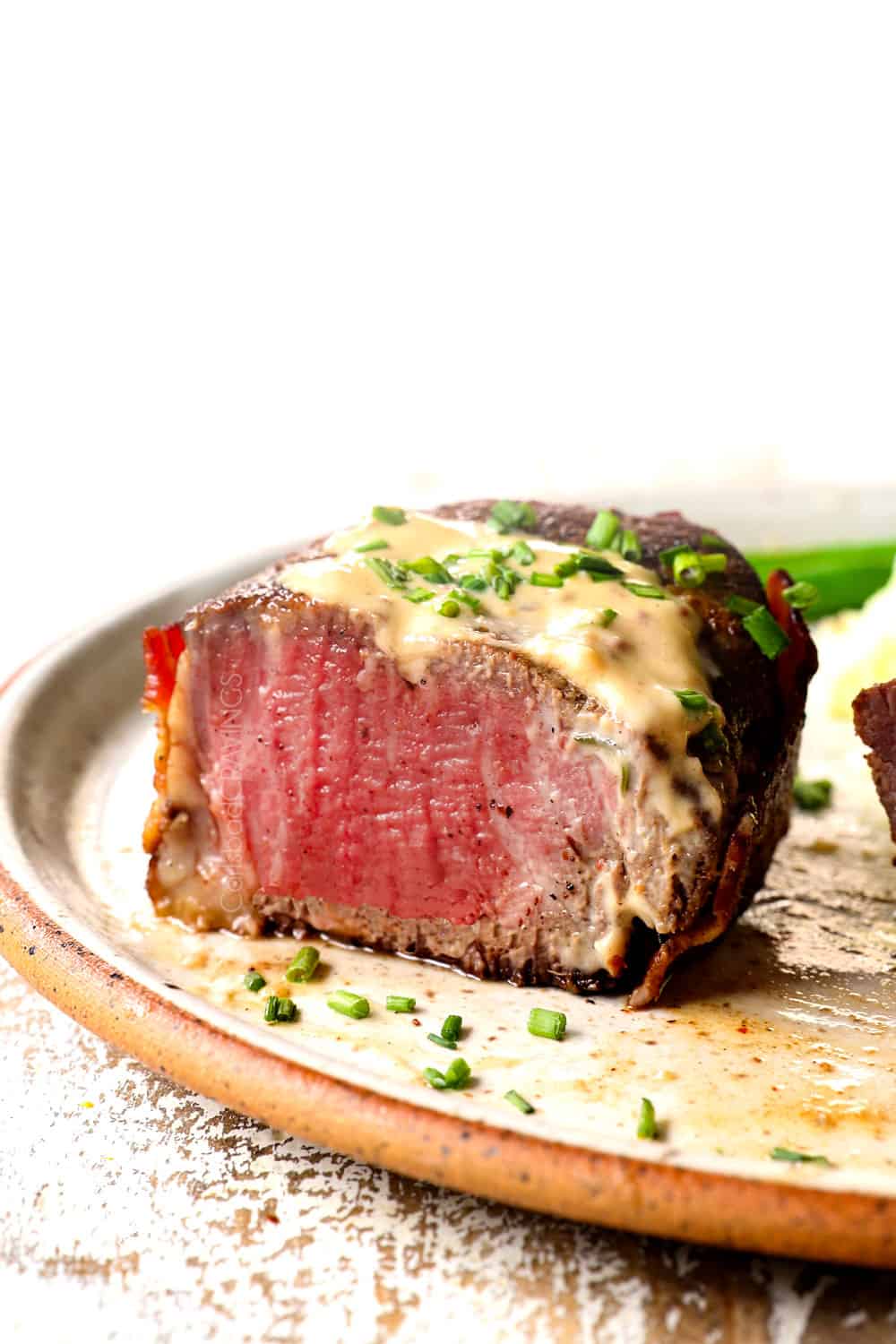
WANT TO TRY THIS filet mignon RECIPE?
PIN IT TO YOUR beef or holiday BOARD TO SAVE FOR LATER!
FIND ME ON PINTEREST FOR MORE GREAT RECIPES! I AM ALWAYS PINNING :)!
©Carlsbad Cravings by CarlsbadCravings.com
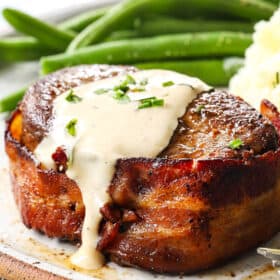
Bacon Wrapped Filet Mignon
Save This Recipe To Your Recipe Box
You can now create an account on our site and save your favorite recipes all in one place!
Ingredients
STEAKS
- 4 (8-10 oz.) filet mignon steaks 1 ½- 2 inches thick
- 2 teaspoons kosher salt
- 1 teaspoon freshly cracked pepper
- 1/2 tsp EACH garlic powder, onion powder, paprika, chili powder
- 8 slices thin/regular cut bacon
- 1 ½ tablespoons vegetable oil
- 3 tablespoons unsalted butter
- 3 cloves garlic, smashed
- 2 large sprigs rosemary
BALSAMIC CHIVE CREAM SAUCE (Optional)
- 1/3 cup low sodium chicken broth
- 1/2 cup heavy cream
- 1 tablespoon balsamic vinegar
- 1 teaspoon Dijon mustard
- 1 1/2 tablespoons chopped fresh chives
- pinch of cayenne (optional)
- salt and pepper to taste
Other Serving Options
- horseradish cream sauce << CLICK FOR RECIPE
- herb butter (see notes)
Instructions
- Remove steaks from refrigerator 60 minutes before cooking to bring to room temperature. Trim steaks of all white membranes and fat if needed.
- Whisk the seasonings together in a small bowl (kosher salt through chili powder). Pat the steaks dry and season all sides with the spice mix, pressing it into the steaks so it sticks; set aside. It is best to season the steaks immediately so they have time to rest for at least 40 minutes. If you don’t season the filets immediealty, then season them right before cooking otherwise they will become dry.
- Preheat oven to 425 degrees F. Arrange bacon strips on a foil lined baking sheet so they aren’t touching. Bake for 6-10 minutes at 425 degrees F or until strips are beginning to turn golden but are still pliable. Drain bacon on paper towels. (Don’t turn off the oven.)
- Using two bacon strips per steak, wrap the steak completely with the bacon, securing with a piece of cotton butcher's twine or toothpicks (twine works much better, the toothpicks can tear the bacon).
- Heat 1 ½ tablespoons vegetable oil in a large cast iron skillet until smoking. Once hot, add the steaks and sear for 2 minutes without moving. Flip the steaks using tongs, add the butter, smashed garlic and rosemary. Cook an additional 2 more minutes, tilting the skillet (use an oven mitt!) and basting the steaks with the melted butter.
- Insert a digital oven safe thermometer into thickest part of steak (if you have one) and transfer the skillet to the oven to finish cooking. Cook at 425 degrees F to your liking, about 4 to 9 minutes. Remove when internal temperature reaches 120 degrees F for rare, 130 degrees F for medium rare, and 140 degrees F for medium. The temperature will continue to rise another 5 degrees as the steaks rest. Immediealty transfer the steaks to a plate and let rest for 5-10 minutes before slicing. Meanwhile make the sauce:
SAUCE
- Drain off all but 1 tablespoon fat/juices from the skillet but leave the rosemary and garlic. Add chicken broth and scrape up any bits on the bottom of the pan; simmer, stirring occasionally for 3 minutes to reduce. Stir in heavy cream, balsamic vinegar and Dijon. Simmer until slightly thickened, about 2 minutes. If you would like more sauce, you can add more cream ;).
- Remove from heat and remove the rosemary and garlic with a slotted spoon. Stir in fresh chives. Season with plenty of freshly cracked salt and pepper to taste and a pinch of cayenne if desired. Drizzle sauce over steaks or serve alongside.
Video
Notes
GARLIC HERB BUTTER
If you’d like to forgo the Balsamic Cream Sauce, this butter is fantastic as well.-
- 8 tablespoons (1 stick) unsalted butter room temperature
- 1 ½ teaspoons lemon zest (optional if you have it)
- 1-2 cloves garlic, finely minced
- 1 teaspoon Dijon or horseradish
- 1 1/2 tablespoons chopped fresh chives
- 2 tablespoons finely minced fresh herbs (pick 2-3 of your favs: parsley, tarragon, thyme oregano, rosemary, basil, etc.)
- 1/8 tsp EACH salt, pepper
Tips and tricks
- Filet mignon: purchase filets from your local butcher or increasingly, groceries are selling the highest quality Prime meats as well. I have purchased Prime Aspen Ridge Natural Angus Beef at Pavilions and Vons. You can use their store locator here.
- Kitchen twine: despite the pics, I highly suggest securing with cotton butcher’s twine instead of toothpicks. The toothpicks will easily tear through the bacon. If you must use toothpicks, use a few per steak.
- Bacon: you must use regular bacon, NOT thick cut bacon or it will remain soggy when overlapped.
- Oil: use a neutral, high smoking point oil such as vegetable oil, canola oil or grapeseed oil. Do NOT use olive oil because it has a lower smoking point and will break down.
- Kosher Salt: is a preferred for steaks because its large texture doesn’t clump like table salt. If you only have table salt, use HALF the amount.
- Pepper: If you are using finely ground pepper instead of freshly cracked, you will need less.
- Use a thermometer: I suggest this digital probe thermometer, which is inserted into the steaks and reads the temperature while they are cooking in the oven.
- Test individual filets for doneness: your filets will likely not be 100% uniform in size, so check the smallest filet for doneness first and be prepared to remove individual filets from the oven as needed.
- Storage: let steak cool to room temperature then transfer to an airtight container. Store in the refrigerator for up to five days.
- Make Ahead: you may spice rub the steaks and refrigerate them uncovered up to 48 hours in advance. Let the filets rest at room temperature for 60 minutes before cooking.

Did You Make This Recipe?
Tag @CarlsbadCravings and Use #CarlsbadCravngs
Leave a Review, I Always Love Hearing From You!
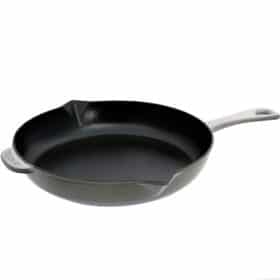
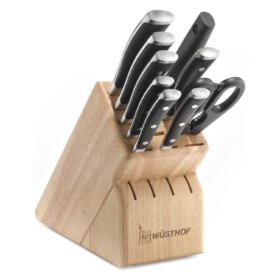
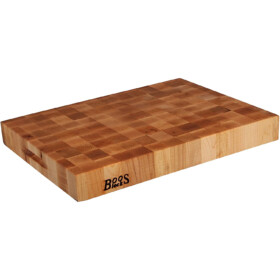
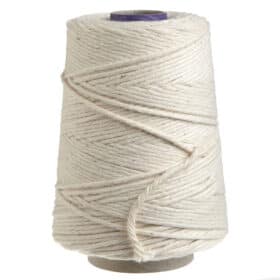
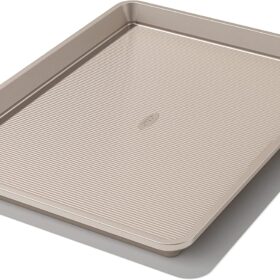
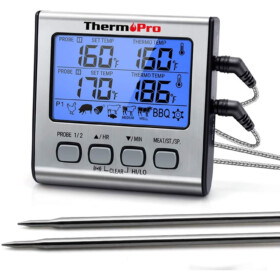
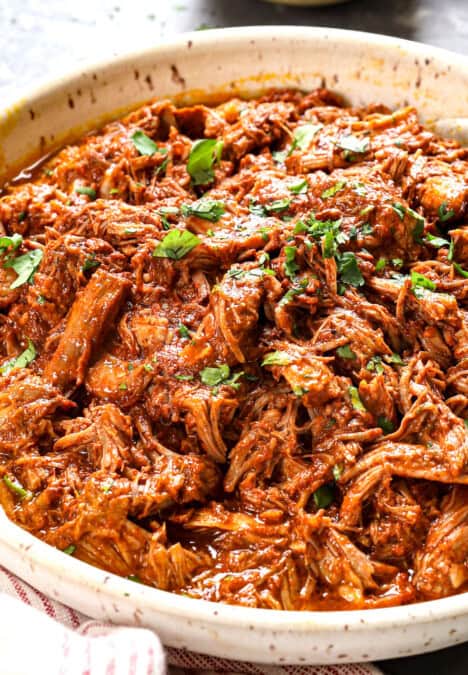
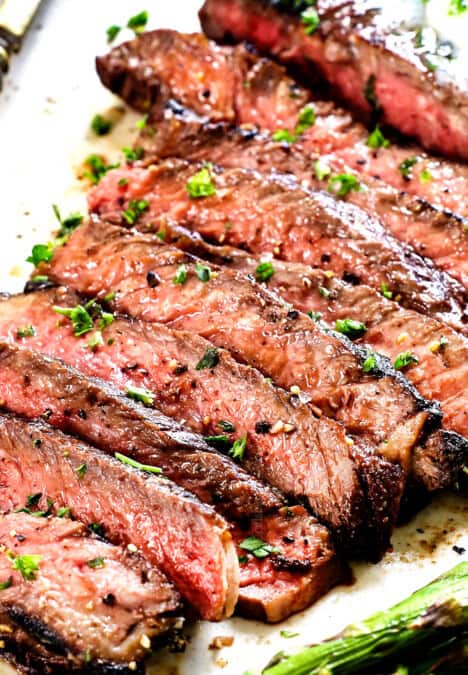

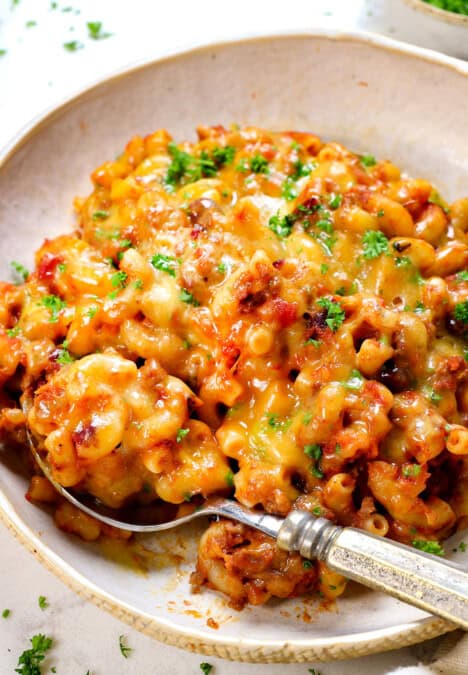

























Natalia says
Wowwwwww, Jen!!! This Filet Mignon is absolutely delicious.I prepared it for 4th of July. My boyfriend told me at least 10 times how good it was. WOW!!! Initially I cook the bacon in the oven for 12 minutes but it broke when I tried to roll it around the steak. So I reaped this step and cook the bacon the second time for around 6 to 7 minutes. I had no problem then and the bacon finished cooking while I cooked the steak.Yes, this is the best steak I have ever eaten.You are a genius!!! Thank you.
Jen says
Thanks so much for taking the time to comment Natalia, I’m thrilled this recipe was such a hit! I’m sorry your bacon broke, but so glad you persevered and cooked the bacon the second time. There is a wide variety of bacon so I appreciate your feedback and have adjusted the baking time in the recipe – thanks you!
Cody says
Unbelievably helpful. I’m cooking filet mignon for Thanksgiving this year, wrapped in bacon, and had so many questions. I found your page while I was stumbling through google, and now I am thoroughly at ease, because I know they can’t help but turn out great with all the details and insight you provided here! Really terrific in-depth article; you provide everything.
Jen says
Thank you so much! I’m glad that this could make your holiday a little less stressful!
Kim says
This was good, but too salty. I’d recommend reducing the salt and/or using unsalted butter. Otherwise we loved it!
Jen says
I’m sorry it was too salty! Yes, unsalted butter should always be used in a recipe. Hopefully it’s perfect next time!
John Lubeck says
We just made this today with creamy mashed potatoes and green beans. Omitted all garlic as my daughter is allergic to it and used shallots instead, Served with the sauce on the mashed potatoes. Really an excellent flavorful exceptional meal.
Jen says
Sounds like an amazing dinner! I’m so glad you enjoyed it!